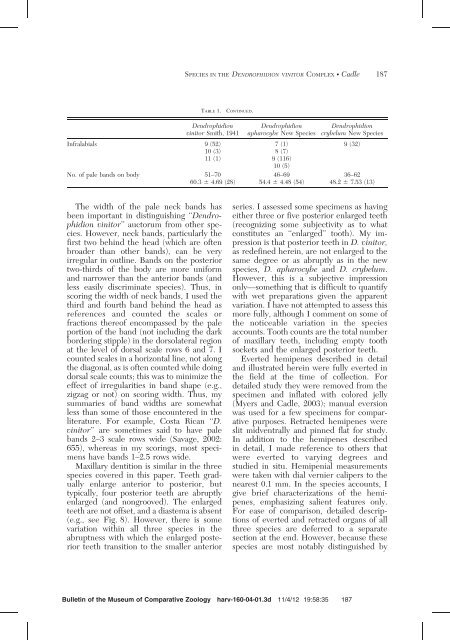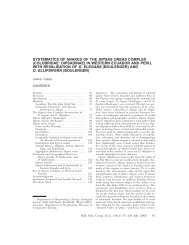cryptic species within the dendrophidion vinitor complex in middle ...
cryptic species within the dendrophidion vinitor complex in middle ...
cryptic species within the dendrophidion vinitor complex in middle ...
Create successful ePaper yourself
Turn your PDF publications into a flip-book with our unique Google optimized e-Paper software.
SPECIES IN THE DENDROPHIDION VINITOR COMPLEX N Cadle 187<br />
TABLE 1.<br />
CONTINUED.<br />
Dendrophidion<br />
<strong>v<strong>in</strong>itor</strong> Smith, 1941<br />
Infralabials 9 (52)<br />
10 (3)<br />
11 (1)<br />
Dendrophidion<br />
apharocybe New Species<br />
7 (1)<br />
8 (7)<br />
9 (116)<br />
10 (5)<br />
Dendrophidion<br />
crybelum New Species<br />
9 (32)<br />
No. of pale bands on body 51–70 46–69 36–62<br />
60.3 6 4.69 (28) 54.4 6 4.48 (54) 48.2 6 7.53 (13)<br />
The width of <strong>the</strong> pale neck bands has<br />
been important <strong>in</strong> dist<strong>in</strong>guish<strong>in</strong>g ‘‘Dendrophidion<br />
<strong>v<strong>in</strong>itor</strong>’’ auctorum from o<strong>the</strong>r <strong>species</strong>.<br />
However, neck bands, particularly <strong>the</strong><br />
first two beh<strong>in</strong>d <strong>the</strong> head (which are often<br />
broader than o<strong>the</strong>r bands), can be very<br />
irregular <strong>in</strong> outl<strong>in</strong>e. Bands on <strong>the</strong> posterior<br />
two-thirds of <strong>the</strong> body are more uniform<br />
and narrower than <strong>the</strong> anterior bands (and<br />
less easily discrim<strong>in</strong>ate <strong>species</strong>). Thus, <strong>in</strong><br />
scor<strong>in</strong>g <strong>the</strong> width of neck bands, I used <strong>the</strong><br />
third and fourth band beh<strong>in</strong>d <strong>the</strong> head as<br />
references and counted <strong>the</strong> scales or<br />
fractions <strong>the</strong>reof encompassed by <strong>the</strong> pale<br />
portion of <strong>the</strong> band (not <strong>in</strong>clud<strong>in</strong>g <strong>the</strong> dark<br />
border<strong>in</strong>g stipple) <strong>in</strong> <strong>the</strong> dorsolateral region<br />
at <strong>the</strong> level of dorsal scale rows 6 and 7. I<br />
counted scales <strong>in</strong> a horizontal l<strong>in</strong>e, not along<br />
<strong>the</strong> diagonal, as is often counted while do<strong>in</strong>g<br />
dorsal scale counts; this was to m<strong>in</strong>imize <strong>the</strong><br />
effect of irregularities <strong>in</strong> band shape (e.g.,<br />
zigzag or not) on scor<strong>in</strong>g width. Thus, my<br />
summaries of band widths are somewhat<br />
less than some of those encountered <strong>in</strong> <strong>the</strong><br />
literature. For example, Costa Rican ‘‘D.<br />
<strong>v<strong>in</strong>itor</strong>’’ are sometimes said to have pale<br />
bands 2–3 scale rows wide (Savage, 2002:<br />
655), whereas <strong>in</strong> my scor<strong>in</strong>gs, most specimens<br />
have bands 1–2.5 rows wide.<br />
Maxillary dentition is similar <strong>in</strong> <strong>the</strong> three<br />
<strong>species</strong> covered <strong>in</strong> this paper. Teeth gradually<br />
enlarge anterior to posterior, but<br />
typically, four posterior teeth are abruptly<br />
enlarged (and nongrooved). The enlarged<br />
teeth are not offset, and a diastema is absent<br />
(e.g., see Fig. 8). However, <strong>the</strong>re is some<br />
variation <strong>with<strong>in</strong></strong> all three <strong>species</strong> <strong>in</strong> <strong>the</strong><br />
abruptness with which <strong>the</strong> enlarged posterior<br />
teeth transition to <strong>the</strong> smaller anterior<br />
series. I assessed some specimens as hav<strong>in</strong>g<br />
ei<strong>the</strong>r three or five posterior enlarged teeth<br />
(recogniz<strong>in</strong>g some subjectivity as to what<br />
constitutes an ‘‘enlarged’’ tooth). My impression<br />
is that posterior teeth <strong>in</strong> D. <strong>v<strong>in</strong>itor</strong>,<br />
as redef<strong>in</strong>ed here<strong>in</strong>, are not enlarged to <strong>the</strong><br />
same degree or as abruptly as <strong>in</strong> <strong>the</strong> new<br />
<strong>species</strong>, D. apharocybe and D. crybelum.<br />
However, this is a subjective impression<br />
only—someth<strong>in</strong>g that is difficult to quantify<br />
with wet preparations given <strong>the</strong> apparent<br />
variation. I have not attempted to assess this<br />
more fully, although I comment on some of<br />
<strong>the</strong> noticeable variation <strong>in</strong> <strong>the</strong> <strong>species</strong><br />
accounts. Tooth counts are <strong>the</strong> total number<br />
of maxillary teeth, <strong>in</strong>clud<strong>in</strong>g empty tooth<br />
sockets and <strong>the</strong> enlarged posterior teeth.<br />
Everted hemipenes described <strong>in</strong> detail<br />
and illustrated here<strong>in</strong> were fully everted <strong>in</strong><br />
<strong>the</strong> field at <strong>the</strong> time of collection. For<br />
detailed study <strong>the</strong>y were removed from <strong>the</strong><br />
specimen and <strong>in</strong>flated with colored jelly<br />
(Myers and Cadle, 2003); manual eversion<br />
was used for a few specimens for comparative<br />
purposes. Retracted hemipenes were<br />
slit midventrally and p<strong>in</strong>ned flat for study.<br />
In addition to <strong>the</strong> hemipenes described<br />
<strong>in</strong> detail, I made reference to o<strong>the</strong>rs that<br />
were everted to vary<strong>in</strong>g degrees and<br />
studied <strong>in</strong> situ. Hemipenial measurements<br />
were taken with dial vernier calipers to <strong>the</strong><br />
nearest 0.1 mm. In <strong>the</strong> <strong>species</strong> accounts, I<br />
give brief characterizations of <strong>the</strong> hemipenes,<br />
emphasiz<strong>in</strong>g salient features only.<br />
For ease of comparison, detailed descriptions<br />
of everted and retracted organs of all<br />
three <strong>species</strong> are deferred to a separate<br />
section at <strong>the</strong> end. However, because <strong>the</strong>se<br />
<strong>species</strong> are most notably dist<strong>in</strong>guished by<br />
Bullet<strong>in</strong> of <strong>the</strong> Museum of Comparative Zoology harv-160-04-01.3d 11/4/12 19:58:35 187







